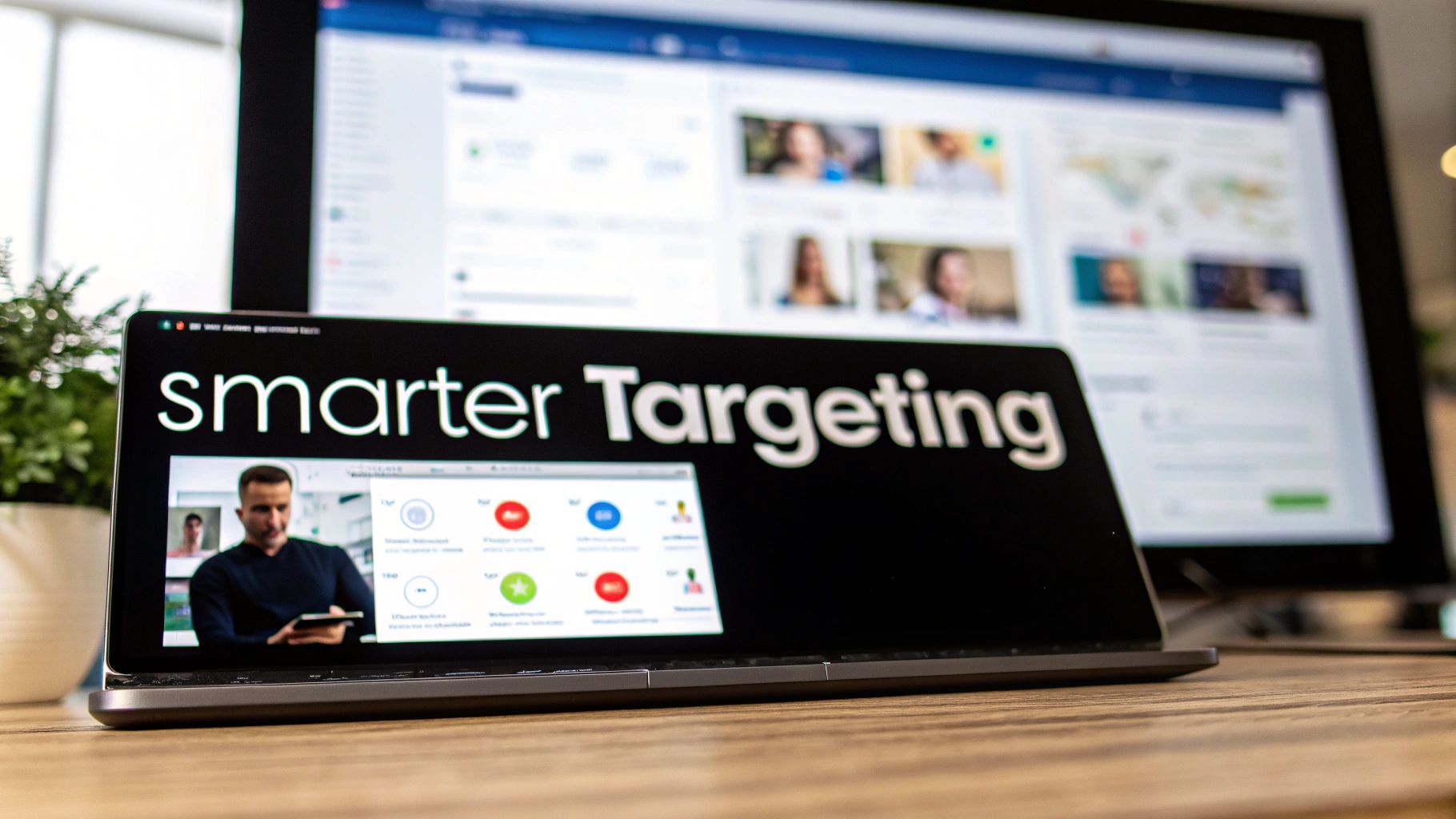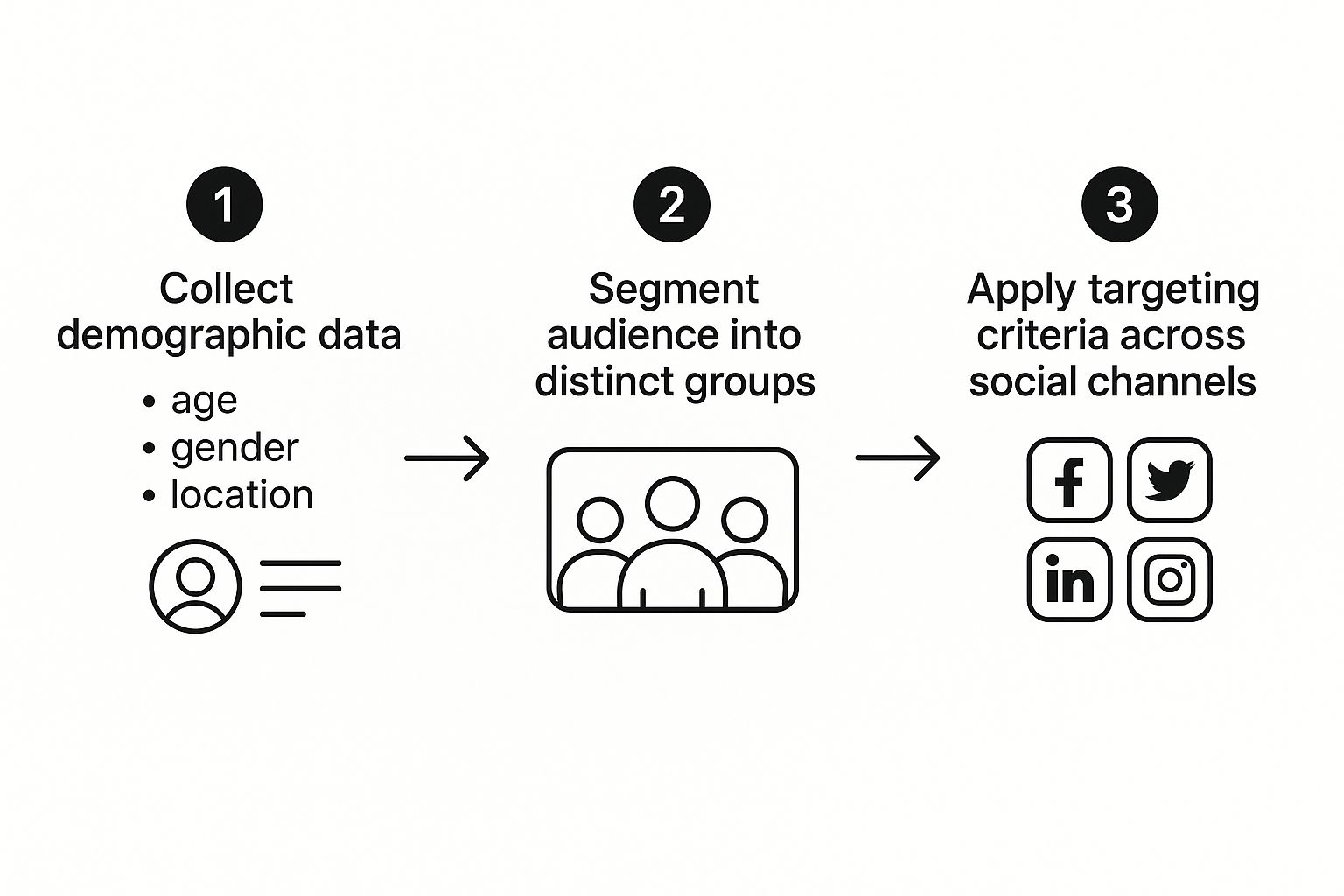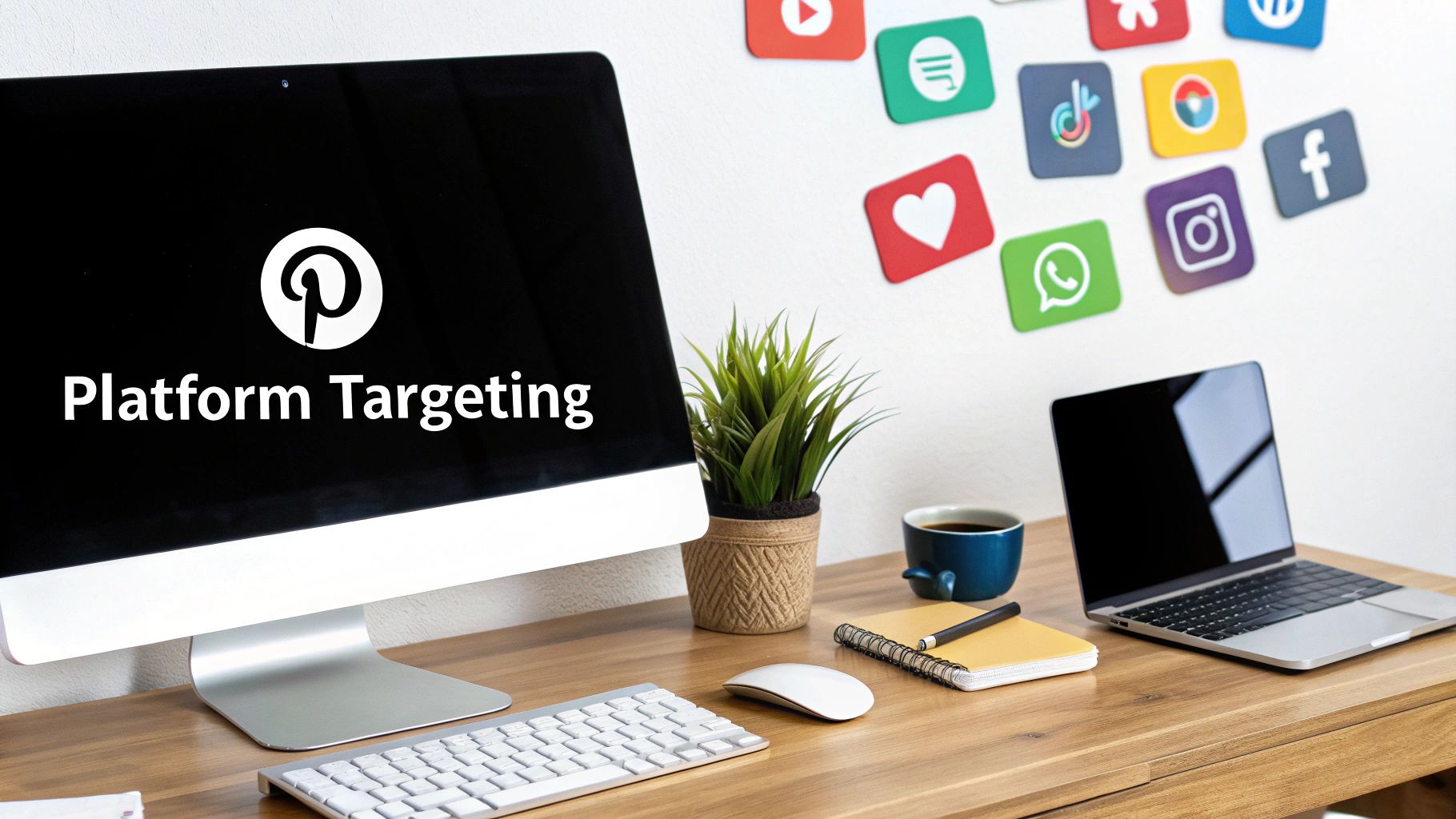
Smarter Social Media Audience Targeting That Works
Unlock better ROI with smarter social media audience targeting. This guide shares actionable strategies for finding and engaging your ideal customers.
Just showing up on social media isn't enough anymore. Honestly, it hasn't been for a long time. In a world flooded with content and literally billions of users, spraying and praying with your marketing is just a fast way to burn through your budget.
If you want to see a real return on your efforts, you have to get specific. Social media audience targeting today is all about digging past the surface-level stuff to find out who your customers really are and what they actually care about.

Beyond Broad Strokes: What Modern Targeting Looks Like
Let's be real—the days of casting a wide, generic net and just hoping for the best are long gone. As of 2025, there are over 5.17 billion people hanging out on social media. That’s a massive ocean of potential customers, but it's also an overwhelming amount of noise. If you want to get noticed, you have to swap guesswork for data-driven precision. For a deeper dive into these numbers, check out the research on social media growth from cropink.com.
Good targeting is the secret sauce. It’s what makes the difference between an ad that people scroll right past and one that feels like a genuinely helpful recommendation from a friend. It’s about meeting the right people, in the right place, at the right time.
The Core Components of Modern Audience Targeting
So, how do you build a strategy that actually works? It starts with a shift in mindset. You have to move away from old-school, surface-level tactics and embrace a much deeper, more nuanced way of thinking. The goal isn't just to find an audience; it's to speak directly to the individuals who are most likely to love what you do. Get this right, and you'll see your engagement and conversions climb.
The most successful campaigns don't just find an audience; they build a connection. This happens when your targeting is so accurate that your content feels helpful and relevant, not intrusive.
To really nail this, you need to understand the foundational pillars of modern targeting. Think of these as the building blocks for every successful social campaign.
This table breaks down the shift from outdated methods to the smarter strategies we're using today.
| Targeting Component | Traditional Approach (What to Avoid) | Modern Approach (What to Do) | | :--- | :--- | :--- | | Demographics | Targeting "Women, 25-40, USA." | Layering in income, education, and family status for a full life-stage view. | | Psychographics | Guessing at broad interests like "fashion." | Uncovering specific values, attitudes, and lifestyles (e.g., eco-conscious, minimalist). | | Behavioral Data | Looking at page likes or basic engagement. | Tracking website visits, past purchases, and specific content interactions to gauge intent. |
By weaving these components together, you start to see the magic happen.
From Vague Ideas to Hyper-Specific Profiles
Combining these elements lets you create a multi-layered, almost three-dimensional profile of your ideal customer.
Let’s take a practical example. Imagine you run a sustainable fashion brand.
- The old way: You might target "women aged 25-40."
- The new way: You target "women aged 25-40 who follow environmental influencers, shop at organic markets, and have recently engaged with posts about ethical production."
See the difference? It’s night and day.
That’s the level of detail that drives real results. This approach ensures every dollar you spend is going toward reaching people who aren't just fleeting viewers, but who have the potential to become your next loyal customers.
Building a Customer Persona That Actually Works
Let's be honest. Most customer personas are useless. They’re often just a collection of vague demographics and stock photos slapped onto a template, created from guesswork and wishful thinking.
Effective social media targeting isn't about casting a wide net; it’s about building a powerful magnet. That magnet is a real, data-backed profile of your ideal buyer. To build one that actually works, you have to stop assuming and start digging.
Your first stop? Your own backyard. Fire up your Customer Relationship Management (CRM) system and look at your sales data. Who are your best customers? Not just any customer, but the ones who come back, spend the most, and leave glowing reviews. Look for patterns in their location, purchase history, and any other info you've collected.
This isn't just about crunching numbers. It's about shifting from "I think my customer is..." to "I know my best customers are..." That's the foundation.
Uncovering Deeper Audience Insights
Okay, you have the "who" from your sales data. Now it's time to understand their "why" and "where." This is where your website and social media analytics become your best friends.
- Google Analytics: Don't just glance at traffic numbers. Dive into the Audience reports to see the age, gender, and locations of your visitors. Even better, check out the Affinity Categories and In-Market Segments. These tell you what your audience is passionate about and what they're actively shopping for right now.
- Social Media Analytics: Every platform's native insights tool is a treasure trove. Instagram will show you follower demographics. Facebook's Audience Insights can reveal the other pages your audience loves, their lifestyle details, and even their education level. This is how you learn who they are when they aren't interacting with you.
For new businesses, building a solid small business social media strategy is non-negotiable, and a sharp persona is the first, most critical piece of that puzzle.
When you blend these data sources, a much clearer picture emerges. You might realize your best customers aren't just "women, 30-45." They're "women, 30-45, living in suburban zip codes, who are into home fitness and follow healthy food bloggers." That's the kind of detail that turns your targeting from a shot in the dark into a bullseye.
A truly useful persona is a living document, not a one-and-done task. You should be tweaking and refining it with every new campaign and every new piece of data you collect.
From Data Points to a Real Person
Data is great, but it's hard to connect with a spreadsheet. Now, we bring the numbers to life by creating a narrative. This helps you and your team actually empathize with your customer.
Let's say you run a direct-to-consumer (DTC) brand selling eco-friendly yoga mats. Your research might point to an ideal customer we'll call "Eco-Conscious Chloe."
- Demographics: She's 32, lives in a city like Austin or Portland, and has a household income over $75,000.
- Interests: She follows @YogaWithAdriene, shops at Whole Foods, and engages with brands like Patagonia and Allbirds.
- Pain Points: She’s tired of flimsy yoga mats made from plastics that harm the environment. She's actively looking for something durable and sustainable.
- Online Behavior: You'll find her scrolling Instagram and Pinterest, saving posts about wellness, travel, and sustainable living.
This simple chart breaks down how you get from raw data to a targeted strategy.

When you have a clear picture of "Chloe," everything clicks into place. You know which interests to target in your Facebook ads, which influencers to reach out to on Instagram, and what kind of message will actually resonate with her.
This is the difference between shouting into the void and starting a real conversation with someone who's already looking for what you have to offer.
Mastering Each Platform's Targeting Toolkit

Knowing who your audience is is only half the battle. The other half is knowing how to actually find them on each social media platform. Every platform has its own unique toolkit, and getting your hands dirty with these tools is what turns a well-researched persona into a campaign that actually delivers.
Think of each ad manager as a different workshop. They all help you build something, but the specific tools and techniques are unique. Let's take a practical tour through the most powerful features on Meta, LinkedIn, and TikTok, moving past the basic stuff and into the strategies that drive real results.
Unlocking the Power of Meta's Audience Tools
For most advertisers, Meta (Facebook and Instagram) is the go-to starting point, and for good reason. Its audience tools are incredibly deep, letting you get seriously granular. The real magic, though, happens when you move beyond just layering interests and demographics.
The two most powerful weapons in your Meta arsenal are Custom Audiences and Lookalike Audiences.
- Custom Audiences: This is your retargeting goldmine. You can build audience lists from people who have already engaged with your brand in some way. This isn't cold traffic; it's a warm list of people who already know who you are.
- Lookalike Audiences: This is how you scale. You give Meta a source audience (like your best customers), and its algorithm goes out and finds millions of new people who share similar characteristics.
Let's say an e-commerce store creates a Custom Audience of everyone who added a product to their cart in the last 30 days but never checked out. They can then run a targeted Instagram Stories ad specifically to that group with a small discount code. That’s precision.
Here's what you're looking at inside the Meta Ads Manager when you start building these audiences.

This dashboard is your command center. It’s where you create, manage, and see how your saved audiences are performing, from simple website visitor lists to highly specific Lookalikes.
LinkedIn for B2B Precision
While Meta is king for B2C, LinkedIn is the undisputed champion for B2B targeting. Its entire data set is built around professional life, giving you direct access to decision-makers based on their careers.
Forget broad interests. On LinkedIn, you can dial in your targeting with laser focus.
- Job Title: Reach "Chief Technology Officers" or "Marketing Managers."
- Company Size: Focus on scrappy startups (1-10 employees) or massive enterprise corporations.
- Industry: Target people working in "Computer Software" or "Financial Services."
- Skills: Find professionals who list "Project Management" or "Java" on their profiles.
Imagine you're a SaaS company selling project management software. You could build a campaign targeting only Project Managers at software companies with 50-200 employees. That level of specificity is nearly impossible anywhere else, and it's why LinkedIn ads cost more—you're paying for extreme precision.
Pro Tip: Don't just sell on LinkedIn. Use its targeting to build brand authority. Target industry leaders with genuinely insightful content, not just sales pitches, to establish your company as a trusted voice.
Riding the Wave with TikTok's Algorithm
TikTok's approach is a different beast entirely. Yes, it has interest and demographic targeting, but its real power is the content-first algorithm. The platform is scarily good at figuring out who will like a video and then serving it to them, whether it's an ad or an organic post.
Your strategy here should be a blend of providing some direction and then trusting the algorithm to do its job. Start with broad interest categories relevant to your niche, like "beauty & personal care" or "tech & electronics."
From there, your main job is to create content that your ideal customer would actually want to watch. The algorithm learns from engagement—likes, comments, shares, watch time—and quickly starts showing your ad to users with similar viewing habits. It's a powerful feedback loop.
Knowing your audience is still key. For example, millennials are a massive force on social media, with about 69% expected to be active users in 2025. Knowing which platforms they frequent helps you focus your efforts. To get a better handle on these trends, you can explore more social media statistics.
On TikTok, your creative is your most important targeting tool. An ad that looks and feels like a native TikTok video will always outperform a polished, corporate-style video. Always.
Using AI to Find Your Untapped Audiences
Let's be real, AI is more than just a buzzword—it's a seriously powerful tool for smarter social media targeting. When you use it right, it’s like having a super-powered data analyst on your team, working around the clock to find pockets of potential customers you’d almost certainly miss on your own.
Instead of getting lost in a sea of audience combinations, AI systems can chew through massive datasets in seconds. They spot patterns, connections, and niche interests that are pretty much invisible to the human eye. This means you can finally move beyond the obvious targeting and uncover brand new, high-potential groups.
How AI Uncovers Hidden Opportunities
Think of AI as your secret weapon for deep market research. You might be targeting users interested in "yoga" and "wellness," which makes sense. But an AI tool can analyze millions of data points and find a goldmine of a sub-segment: people who follow specific minimalist home-decor influencers, buy organic coffee beans, and also engage heavily with content about sustainable travel.
Would you have ever pieced that exact combination together on your own? Probably not. AI automates this discovery, handing you data-backed audience suggestions that are lightyears beyond basic demographics. It connects the dots between seemingly random behaviors to build a much richer picture of who your customer actually is.
The real magic of AI in targeting is its ability to find the "why" behind the "what." It doesn't just see that someone liked a page; it understands the web of interests that signals they're actually ready to buy.
This kind of insight is a game-changer. In fact, a staggering 90% of businesses using AI for social media report saving a ton of time and seeing better engagement. The tech handles the grunt work, freeing you up to focus on the creative stuff that matters. You can dig into the specifics by reading the full report on social media targeting improvements.
Predictive Analytics and Automated Optimization
One of the coolest things AI does is predict what's going to happen next. It looks at all your past data and real-time performance to forecast which audience segments are most likely to convert for a specific campaign.
This predictive power has a direct impact on your budget and how efficiently you spend it.
- Smarter A/B Testing: Forget manually testing dozens of audience variations. AI can run its own micro-tests, quickly find the winning combos, and automatically shift your budget to the top performers.
- Real-Time Ad Spend Optimization: AI-powered tools are on watch 24/7. If an audience suddenly gets too expensive or stops responding, the system can instantly move your ad spend to a different, more profitable group to maximize your return on ad spend (ROAS).
Let's say a small e-commerce brand selling handmade leather goods uses an AI tool to launch a campaign. The tool might start by testing ten different audience profiles. Within hours, it figures out that "men aged 30-45 who follow artisanal craft blogs and have recently purchased from Etsy" is crushing all the other groups.
The system then automatically funnels more of the daily budget to that specific audience while pulling back from the ones that aren't working. This all happens without the marketing manager having to do a thing. It’s a massive leg up, allowing smaller businesses to compete with huge companies that have entire teams dedicated to ad management. This continuous optimization loop ensures your targeting is always as sharp and cost-effective as it can be.
Advanced Targeting for Social Commerce

As social platforms transform from simple hangouts into full-blown marketplaces, your social media audience targeting needs a major upgrade. When the "add to cart" button is just a thumb-tap away, you have to move beyond broad awareness and get laser-focused on high-intent signals.
This isn't about just reaching people who might be interested. It's about segmenting your audience based on actions that scream, "I'm ready to buy." This is the critical shift that turns casual scrollers into loyal customers.
Target Users Based on High-Intent Actions
Forget simply targeting people who "like" your page. For social commerce, the real wins come from targeting users who are already interacting directly with your products. Platforms like Meta have built incredibly powerful tools for this.
You can now create hyper-specific audiences based on concrete actions people take in your digital storefront. These are some of the most valuable, high-ROI segments you can possibly build.
- Viewed a Product: Group together everyone who clicked on a specific product in your Instagram Shop or Facebook Catalog.
- Added to Cart: This is a classic for a reason. Target anyone who put an item in their cart but got distracted before checking out.
- Initiated Checkout: This is your lowest-hanging fruit. These are users who were just one step away from giving you their money.
Let’s say you sell custom phone cases. You can build an ad campaign that only targets users who viewed the "iPhone 15 Pro Max" case in your Instagram Shop within the last 7 days. Your ad? A quick video of that exact case with a simple CTA: "Complete Your Order." That level of direct personalization is ridiculously effective.
The closer a user's action is to a final purchase, the more valuable that audience segment becomes. Always prioritize targeting users who have initiated checkout or added to their cart over those who have only viewed a product.
Drive Sales with the Right Platform Focus
Not all social commerce platforms are created equal. Where you focus your energy depends entirely on who you're trying to reach. TikTok’s audience behaves differently than Pinterest’s, and your strategy needs to reflect that.
Platform Focus for Social Commerce
Here’s a data-driven look at which platforms are leading the social commerce charge and where to focus your targeting efforts for maximum sales impact.
| Platform | Key Audience Demographic | Primary Commerce Feature | Best For | | :--- | :--- | :--- | :--- | | Instagram | Millennials & Gen Z (25-34) | Instagram Shops, Product Tags | Visual-first brands (fashion, beauty, home decor) | | Facebook | Gen X & Millennials (35-54) | Facebook Shops, Marketplace | Broad-appeal products, community-driven sales | | TikTok | Gen Z (18-24) | TikTok Shop, In-feed Video Ads | Trend-driven products, viral marketing | | Pinterest | Millennial Women (30-49) | Product Pins, Shopping Lists | Aspirational products (DIY, weddings, home goods) |
Choosing the right channel is half the battle. By aligning your product with the platform's core user base and commerce features, you're setting your campaigns up for success from the start.
Partner with Micro-Influencers for Niche Audiences
When it comes to social commerce, chasing the biggest names in influencer marketing isn't always the smartest play. Micro-influencers, who typically have between 10,000 and 100,000 followers, often deliver far more bang for your buck. They cultivate highly engaged, niche communities that can perfectly mirror your ideal customer.
The real work is in finding creators whose followers are your target audience. Dig deeper than follower counts—look at their engagement rates, the quality of comments, and the other brands they partner with. A micro-influencer in the "sustainable home goods" niche is a potential goldmine for an eco-friendly cleaning brand.
This strategy is backed by some serious data. The influence of social media on purchasing is undeniable, with a staggering 82% of consumers using these platforms for product research. As you can see in these key findings on social media's impact from Sprout Social, nearly half of all purchases are now influenced by creators. This makes targeted partnerships absolutely essential.
Drive Conversions with User-Generated Content
Nothing builds trust faster than seeing real people using and loving a product. User-generated content (UGC) is the ultimate social proof, and you can build entire high-converting campaigns around it.
Actively encourage your customers to share photos or videos featuring your product. Once you have their permission, put that content to work in your ads. A killer strategy is to run a UGC-based ad targeting a "lookalike" audience built from your existing customer list. The platform's algorithm will then hunt down new users who share key traits with the people who already buy from you.
This creates a powerful and authentic feedback loop. A potential customer sees an ad starring a real person—not a polished model—and it instantly builds credibility, making that "Shop Now" button feel much more trustworthy. It's a direct, authentic, and incredibly effective way to drive sales right inside the app.
How to Measure and Refine Your Targeting
Getting your social media audience targeting right isn't something you set and forget. It's a constant cycle of testing, learning, and adjusting. Launching your campaign is just the starting line. The real work begins the moment data starts trickling in, showing you what’s hitting the mark, what’s falling flat, and where your best opportunities are hiding.
It's easy to get sidetracked by vanity metrics like likes and impressions. Instead, you need to zero in on the numbers that actually reflect the quality of your audience and, ultimately, your bottom line. These are the metrics that tell you if you're reaching the right people.
Key Metrics for Audience Analysis
To get a truly clear picture of your performance, you have to track a few specific metrics. More importantly, you need to look at them through the lens of your different audience segments.
- Cost Per Result (CPR): This is your price tag for each desired action, whether it's a lead, a click, or a sale. If you see a sky-high CPR in one audience segment, that’s a red flag signaling a mismatch between your ad and the people seeing it.
- Conversion Rate: This tracks the percentage of people who click your ad and then actually follow through with the desired action. A low conversion rate, even with a ton of clicks, often means your targeting is attracting curious window-shoppers, not qualified buyers.
- Return On Ad Spend (ROAS): This is the ultimate measure of profitability. When you break down ROAS by audience, you can see exactly which groups are making you money and which are just draining your budget.
For example, you might discover that your Lookalike Audience has a wonderfully low CPR, but your Interest-Based Audience delivers a much higher ROAS. That’s a powerful insight. It tells you exactly where to shift your ad spend for better returns. Digging into these numbers is non-negotiable, and you can get a more detailed breakdown in our full guide on how to measure social media ROI.
Don't get discouraged if a new audience seems to underperform at first. Think of it as a learning opportunity. The data is simply telling you what that specific group doesn't respond to, which is just as valuable as knowing what they do.
The Optimization Loop
This whole process of analysis feeds into a simple but incredibly powerful cycle: Test, Measure, Refine.
Start by running small, controlled A/B tests with your different audience segments. Let them run for a set period, then dive into your ad manager’s reporting. Your job is to find the winning combinations of creative and audience that give you the best CPR and ROAS.
This continuous refinement is absolutely crucial. Social media ad spend is projected to soar to $276.7 billion in 2025, and a massive portion of that is aimed at mobile users. That means your targeting has to be razor-sharp to stand out on these incredibly crowded platforms. You can find more details on these spending trends from these insightful social media statistics.
By constantly analyzing performance at the audience level, you stop throwing money at the wall and start making strategic investments. You turn your ad spend into a powerful tool that works smarter, not just harder, to find your next best customer.
Answering Your Top Social Media Targeting Questions
Even with the best strategy in place, you're bound to hit a few snags when you get into the weeds of social media audience targeting. Getting the right answers can be the difference between a campaign that soars and one that just burns through your budget.
Let's clear up some of the most common questions I hear from marketers.
How Long Until I See Real Results?
This is a big one. You launch a new audience, and you're anxious. While you might see some likes and comments trickle in within a few days, you need to be patient.
Realistically, it takes at least 2-4 weeks of consistent running and tweaking to get enough data to know if an audience is a winner. Don't get trigger-happy and kill a campaign after 48 hours. Give the algorithm time to learn.
Custom vs. Lookalike Audiences: What's the Real Difference?
It's easy to get these two mixed up, but they serve very different purposes.
- Custom Audiences: These are your "warm" leads. Think of people who have visited your website, signed up for your newsletter, or engaged with your Instagram page. They already know you, which makes them perfect for retargeting campaigns to close a sale.
- Lookalike Audiences: This is where the platform's AI finds brand-new people who share traits with your best customers. They're a "cold" audience, sure, but they're a highly qualified one, making them your go-to for finding new customers and scaling up.
How Much Should I Actually Budget for Testing?
You have to spend money to make money, and that’s especially true for testing. A solid rule of thumb is to set aside 15-20% of your total campaign budget just for experimenting with new audiences and ad creative.
Think of it not as wasted cash, but as an investment. The data you gather from that 20% will make the other 80% of your budget work exponentially harder for you.
Don't be afraid to cut an underperforming audience, but only after you have enough data. A low conversion rate over two weeks is a clear signal to reallocate those funds to a better-performing segment.
Ultimately, great targeting isn't a "set it and forget it" task. It's a constant cycle of targeting, measuring, and refining. The more you do it, the better your instincts get, and the better your campaigns perform. A bonus? All this focused effort will naturally improve your organic reach, too, which you can learn more about in these proven social media engagement tips.
Ready to stop guessing and start creating content that hits the mark every time? With ViewPrinter, you can build dynamic, AI-powered content tailored to your perfect audience in seconds. Generate viral slideshows, design ideal customer avatars, and schedule everything seamlessly. Start creating with ViewPrinter today.